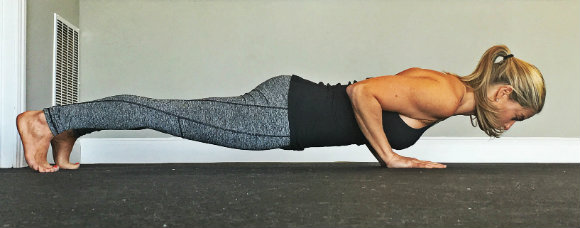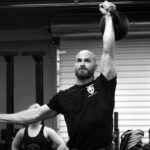If one good repetition is great then more must be even better, right? In the fitness industry, we see more and more crazy trends toward massive amounts of volume. The “GO HARD or GO HOME” mentality. It really isn’t the volume that is so terrible with these approaches, but rather the quality of the movements done at these high volumes. There’s no value in how heavy or how quickly you can do something, if you’re doing it all with poor technique.
Any trainer or instructor can beat you into the ground using crazy moves and loads of volume with minimal rest, but will that actually get you stronger while keeping you safe and injury free? No! While you might initially make strength gains, the risk of injury is greater than the potential rewards—especially since you might get injured before you even reap those rewards.
We, at StrongFirst, would rather see you do quality single reps than multiple reps done poorly. StrongFirst’s philosophy for training is to treat each session as a practice, not a workout. Listen to Pavel explain this distinction:
So if we’re going to start from the basics as far as volume goes, i.e. a volume of one rep, then let’s also start with a basic movement that most people could use some practice at perfecting. The pushup has been around since the beginning of time, but is still regularly butchered.
Done correctly, the pushup will give you great strength gains and can be done anywhere at any time. It also has endless progressions that will enable you to continue advancing over time. But first, we need to make sure you can do one repetition with solid form, and then we’ll go over how to use the grease the groove (GTG) approach to training before worrying about increasing volume or weight.
How to Do One Perfect Pushup
Watch the video for a demonstration of excellent pushup form.
Instructions:
- Start on all fours
- Place your hands slightly narrower than your shoulders (this is more shoulder friendly)
- Focus your eyes on your fingertips while gripping the ground
- Extend both legs out straight with feet approximately shoulder width apart
- Point your belly button toward your face (posterior pelvic tilt)
- Make a “Tssss” sound via tension breath to tighten your whole body
- Corkscrew your shoulders into their sockets and visualize making an “X” on your back
- Row your body toward the floor while moving as one unit, with zero sagging or hunching
- Keep your elbows in fairly close to your rib cage—no chicken winging allowed!
- Pause momentarily at the bottom
- Visualize sending compressed air from your belly out through your palms as you power back up
- Approach your setup and each single rep with intent
By focusing on single reps, you will find that you automatically increase your percentage of quality reps. And you might be amazed at how few quality reps are actually needed to make strength gains. You will also learn a lot about your body and master the required amount of tension for a great pushup. This will allow you to increase your baseline of strength and in return all skills will become easier.
Training the Perfect Pushup With Grease the Groove
Pavel coined the term grease the groove, and this unconventional approach to training has proven to be one of the best methods for quick strength gains. The key to GTG-style training is that you train often but never to failure.
GTG training allows the nervous system to develop and become more proficient. Basically, it teaches your nerves and muscles to work together better, which enables you to move more efficiently, and over time the movement itself becomes much easier. Watch this video for a brief explanation from Pavel:
While GTG works best with bodyweight movements, it is not only for bodyweight skills. It has been known to rapidly increase kettlebell pressing and squatting strength. GTG is also a highly recommended training approach for tactical communities (law enforcement, firefighters, military, etc.) as they never know when they will be called upon and need to be fresh for the job at hand.
GTG works best when you focus on no more than two skills at one time, and the skills should be performed at about 50% of your max. If you are used to the “go hard or go home” mentality, then GTG may take some getting used to. Pavel explains more about the rest time and intensity level of this approach in this video:
GTG does not have to be a standalone program, but it can be. And once you have mastered your selected skills, they can be added into a more traditional program and you can continue your GTG protocol with a new set of skills.
Perfect Pushup Training Protocol
First, test yourself using the perfect pushup instructions listed above to determine your current strength level. If you cannot meet the required steps for a single repetition on the ground, then select an elevation appropriate for your current strength level.
Once you have tested your perfect pushup at different elevations and determined your working elevation, you can proceed to greasing the groove at that level. For example, if you are comfortable and can execute perfect technique at a desk height, then throughout the day do “sets” of one good rep at that height, allowing at least fifteen minutes of rest between each rep. For best results, do your GTG pushups at a minimum of three days per week.
If you meet all the requirements in the perfect pushup instructions, then proceed to test your max reps without losing form or test a harder progression, but only select a progression where you can maintain the proper form. One you have chosen a progression, then, just as stated above, GTG at this progression for a single perfect rep throughout the day at least three days per week.
Grease the Groove Over the Course of Your Week
Remember, in order to get the most out of each GTG session, it is best to select no more than two skills to groove at the same time. I would recommend pairing something like the pistol and the pushup. Each can be done for perfect reps and not take away from the other. You can select to GTG the two skills on the same day or alternate the days, which would give you a daily GTG practice.
If your schedule is more limited, then you can do the two skills on the same day and back to back, then rest at least fifteen minutes before the next set. For example: one pushup followed by one pistol per leg, then rest for at least fifteen minutes and return to your next pushup and pistol.
If you have questions on perfect push-up form or the grease the groove protocol, please post them to the comments below.







Why the ekbows must be close to the body? I thought there are two versions of classic push ups.. with close elbows and with chicken wings..XD These with chicken wings are dangerous for shoulder or something? I thought that chicken wings builds strength of chest and biceps and these with close elbows are for triceps etc.
This was an excellent article. I do have a problem though with one of the cues for a perfect pushup, “Corkscrew your shoulders into their sockets and visualize making an “X” on your back”. I am not sure what the visualize making an X on your back part is all about.
One suggestion, as much as informative the one repetition video is, I still think more repetitions would be even better to grasp the mechanics of a pushup.
Just found the answer in the previous comments :-).
Hi I am excited to start doing the GTG. But please clarify you mean to say that we are supposed to do half the reps we are capable of and do it every 15 minutes all throughout the day, correct ? If so then what about when I have food, I dont exercise atleast for 3 hours after I have a meal in order to avoid any complications.
Please advise if its ok to follow the GTG while incorporating the break of 3 hours after every meal ?
Also I make videos of my push ups in order to make sure I have he perfect form. Is it possible to send you the video to get your advise and feedback ?
Fawad I believe you do not have to exercise every 15 minutes for GTG. Leave at least 15 minutes between each set. There is no number of sets per day specifically prescribed. The point of GTG is to stop halfway before you are maxed out, so in one day you may not be doing more than a few sets. And yes, I agree with the break after meals. I have also found from experience that I need at least an hour after eating, but you probably are in tune with your body. Train when you’re ready!
great breakdown of the push up with different escalations…since i’m a beginner at pistol squats, could you suggest ways to scale back for these?….and can you suggest other combos to try that would work well with the GTC strategy?…thanks!
Hey Suzy, I have just begun to do pistols and am very excited about it. I tried different variations but the most effective was inspired by one of Karen Smith’s videos. Simply do the pistol, go down as far as you can, then come back up before you lose balance. Just like with GTG, take a 15 min or more break before your next try on that same leg. I just tried both sides, waited 15 min, then tried again. I did this about three times a day. Took a long time, weeks.
I think the elbows should be right above the wrists, rather than slightly behind as in your demo, as it creates an unnecessary lever arm and loads the elbow joint at the expense of properly loading the shoulder joint.
Thanks for the article, Karen.
While I try to practice perfect push up form I was wondering whether form should be altered for a selection test. For example, if the goal is to do as many pushups in one minute as possible would you recommend doing ‘perfect pushups’ or would you suggest some alteration to maximize reps?
This is an example of practice vs. performance. When you practice, or train, always use perfect form and the appropriate number of reps. The application is that when it comes time to perform, for a test or for a real life emergency, you have your training as a foundation. You give all your energy, determination, and excitement to accomplish whatever feat you must in that moment. But in practice, in training, go for perfection.
Will GTG be effective if the sets are done throughout the day somewhat sporadically? For example, if I can’t be sure to do a set every 15 or so minutes, but I can do 10 or so sets throughout the day with at least a 15 minute break? With my schedule I would probably be doing them every 45 mins or so, give or take. Thank you!
I ve had the following question in mind for a while and it seems appropriate to ask you as I see in your credentials you do plans for your clients.
I ve read and listened to Pavel quite a bit now, and he refers to starting with strength (as long as it s safe) and it s the basis for any fitness improvements (hence Strong First).
I did a NASM certification a few years ago and it was an opposite philosophy: starting with long reps, in a slow manner, and challenging the ballance of the client.
My question then: at StrongFirst, or just in your opinion, when is it appropriate and useful to do longer reps like 12+ reps? If of any use I wonder…
thanks and agreed with the previous comments, very good description and article, well done!
Benoit
Benoit, I think the most practical time to do more than 5 reps is if you need to warm yourself up in a cold environment. There’s no need to do 12 reps in a row to learn balance. By the end of that, a person would be tired and lose concentration.
would a regression be hands on a raised surface like a step/yoga block ?
Yes, a regression from a perfect floor push up would be any elevation (block, step, bench, desk or counter top, or even the wall) that is used to allow proper form until strength is gained. Then select a lower elevation and repeat. Working a full pushup on an incline has greater benefit then doing pushups on ones knees.
Karen,
Great article – a really clear description of hand and elbow placement and how to connect everything with breathing tension. Thank you.
Thank you
Really good article!
While I don’t understand the ‘X’ cue, the handplacement in the video was great to see as it made me realize I have been trying to “row” all the way to my belly button for quite some time while not understanding why I felt like tipping over.
I really hope we will see more of these “how to” articles of the basic movements.
We will being doing more “how to” articles soon.
As for the “X” cue – if you visualize taking your right lat and putting it in your left back pant pocket and the left lat in the right back pocket… This would be the “X” that I am speaking of. This helps people engage the lats and remember to tense the glutes in order to move the body (descend and ascend) as one unit vs sagging and disconnecting.
That visualization is really powerful! I’ve tried it not only during pushup tests, but also when I tested to start progressing from L-sit to manna, and after that I tried the tucked front lever. . . and it allows me to lock the scapulae and the entire back like one unit so they became possible.
Thank you!
What is the range of motion standard you are describing, I.e. “the bottom”?
Karen,
What a great cue, visualize an X on your back to cue corkscrewing the shoulders into the socket. Is that cue something that transfers well to pull ups?
Charles
Absolutely, this cue works for most skills were we want to maintain packed shoulders. 🙂
Could you elaborate on the cue “visualize making an “X” I’m having trouble connecting that thought with torque/screwing at the shoulders. Are these thoughts related?
When I read visualize and X on my back It made me think about trying to “zip up” my right leg to my left shoulder and my left leg to my right shoulder.
Thanks!
Look above regarding the “x” cue as Tony De Wall also had a question about this visualization and I went into greater explanation there. If it is still not making sense, please feel free to email me at karen.smith@strongfirst.com
Hi Karen-
Another excellent article –thanks.
1) how often would you test yourself for reps–would the next GTG goal be do 50% of that number? and
2) if so, when would you go to the next progression with GTG?
I appreciate your help–thanks again.
I would stick with one progression or elevation for 2-4 weeks to set a solid base then progress accordingly. On your test day if you can do 3 solid sets of 5 then I would move to a lower elevation and begin the GTG for perfect singles over again.
Great Article again Karen. Do you recommend any minimum number of singles for program to be effective? Can as little as 5 in a day be enough? Thanks
The minimum number of singles will vary from person to person, due to the starting strength or baseline and progression selected.
Thanks Karen, in my case I was thinking about chin-ups. My max being 1-2 on the first set. I did manage 6 singles yesterday though, so I was wondering if that would get me started properly until I could do 10-12 singles or sets of 2.
Absolutely… Start where you are and add a rep or so daily.
If you would have no ability to do pull-ups, but just kb work (S&S to be specific) would you still do push-ups or is there a risk of imbalance or any other stuff like that, or is it simply just benefits of doing them?
Stefan –
I would still do pushups even if you can not do pull-ups. When you work a slow negative (rowing to the ground) as we teach in the SFB Course and Certification for all pushups, you are getting a pull. Not necessarily the same level as say a full pull-up but you do get benefits from pulling yourself down prior to pushing back up. As you move on to One Arm or One Arm/One Leg you will begin to feel and see more of this rowing power and strength gains.
Enjoy!
Karen
Awesome Karen!
When I say “no ability to do pull-ups” I mean at home .. trying to save som time to do my workouts at home rather than in the gym. But thanks for your reply, I´ll put them in!
Another excellent article Miss Smith, Thanks a lot !!!!
You are welcome, & Thank you.
Great clarity and writing Karen!
GTG is one of my favourite Pavel/StrongFirst concepts. I still have to fight a strong urge to push past the 50% (of max rep) target but I guess that comes from a lifetime of hearing more/harder is better.
Maybe not!
Thanks Carl.
Yes, it does take a mind shift to move away from the harder-is-better mode. Since learning and making the change in my training, I train far less than in the past and continue to make strength gains.
Best of luck in your strength journey.
Karen